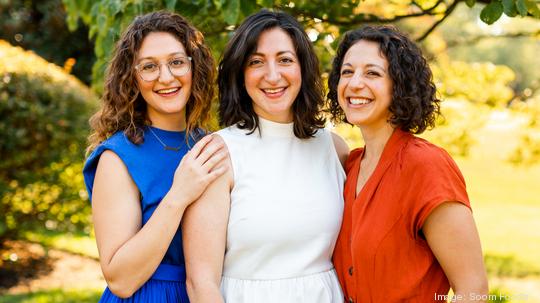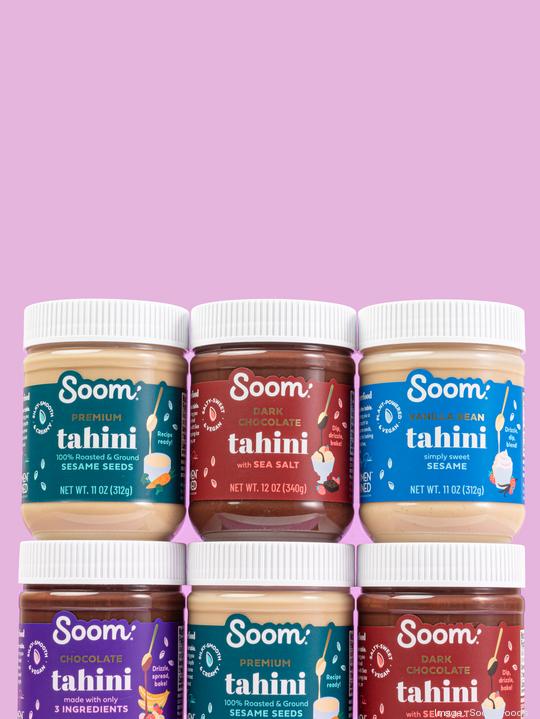
A decade ago, most of the people the Zitelman sisters surveyed didn’t know what tahini was or only associated it with hummus. They saw the lack of awareness for the sesame-derived staple as an opportunity to own the segment.
Since then, the sisters – Amy, Jackie and Shelby – have worked to do just that through their Philadelphia company, Soom Foods.
Following years of grassroots growth in the food services industry, the brand turned its attention to the consumer market during the Covid-19 pandemic and recently landed on the shelves of Whole Foods Markets nationwide. Now, Soom Foods projects it will more than double unit sales year over year in 2022 and is looking to close out a seed funding round of up to $2 million.
Growing up in Maryland, even the sisters largely thought of tahini as being for falafel and shawarma. That changed when they each in turn lived in Israel, where Jackie still lives. It was during their time there that they realized how dramatically different the quality of the tahini was and that it had much broader applications than they were used to, including in baking.
The idea for Soom came in part after Jackie started dating her now husband Omri. At the time Omri was a tahini distributor who later began importing sesame seeds from Ethiopia. On a visit to see Omri’s family, the sisters sampled one of Omri’s mother’s cakes, which was made using tahini.
They were intrigued and saw an opportunity in the U.S. market, so the sisters began creating a business plan, formally filing paperwork for Soom Foods in November 2011.
The sisters decided to set up shop in Philadelphia partially because of their connections to the city – their mom is originally from the area and Shelby attended the University of Pennsylvania – but also because of its foodie scene. “What was amazing to us about Philly was the access that we felt we had to the restaurant scene and to these chefs, and then also infrastructure-wise,” said Shelby, noting the city's proximity to ports, warehouses and the entire Mid-Atlantic corridor also played into their decision.
Today they operate out of facility on East Erie Avenue in North Philadelphia, a larger space than the corner of a warehouse they used early on.
In 2013, they imported their first tahini and entered the market, reaching out directly to restaurants and small retailers. Most were uninterested. But things changed when Michael Solomonov of Zahav fame gave them a shot. Not only did he use Soom’s tahini at the restaurant, but when asked about some of his dishes for a story in the Wall Street Journal, he name-checked the brand.
The sisters got another nod in the Zahav cookbook, further boosting Soom’s cachet.
“That Zahav cookbook especially – that had such national, really international, success – really put Soom on the map,” said Amy, the company’s CEO.
For much of its first five years in business, Soom focused on restaurant wholesale accounts. At one point, as much as 80% of revenue came from the food services industry, the sisters said.
“It was a unit of economics consideration,” said Amy. “The fact that a restaurant uses more tahini and more often than a home cook was very important to the growth of our company.”
Still, their goal remained to transform how Americans thought about and consumed tahini. “Our dream starting Soom was that we would get tahini onto every grocery store shelf and into every kitchen…,” Amy said.
When the Covid-19 pandemic hit in 2020, it provided them the opportunity to switch up their business model, making consumer sales a bigger focus. At the time, Soom was already available in Whole Foods stores throughout the Mid-Atlantic and parts of the Midwest, as well as on Amazon, in some independent stores locally and on the company's website, but those sources didn’t account for a significant share of business.
With more people home during the pandemic, reaching individual consumers “in that short amount of time really changed the dynamic of Soom from being primarily a wholesale, larger-quantity mover of tahini to then enforcing that idea of being a consumer-packaged good,” said Amy.
Part of that success included the acquisition of sesame seed butter competitor Seedible, which has since been folded into Soom. The deal closed in early 2021. Its founder, Daniel Aronhime, was brought on as chief growth officer, helping facilitate partnerships.
Now, about 40% to 45% of revenue comes from consumers and retail wholesale, with the remaining 55% to 60% coming from the food services industry.

While the brand is best known for its tahini, Soom has added a few different offerings, including chocolate tahini and a silan date syrup. At present, Soom has about a dozen SKUs, which range from a 40 lb. bucket of tahini to one-ounce squeeze packs. Its dark chocolate tahini with sea salt and original tahini are both stocked in Whole Foods nationwide in 11-ounce jars.
The sesames for its tahini are imported from Ethiopia and the tahini is then imported from Israel. The sisters believe the combination of their sourcing and the fact that Jackie, the company’s chief product officer, remains in Israel, set Soom apart. Like wine grapes or coffee beans, “it's really the seed that's important,” Jackie said.
Their updated business model is proving successful so far. In the first half of 2022, Soom had already sold over 2 million units, the most it has ever sold of its product, representing a 50% year-over-year increase. Having entered Whole Foods nationwide late this spring, the sisters project that number will comfortably surpass 4 million units by the end of the year.
Now that they’re focused on consumers, the sisters are raising funds to further scale business. Earlier this year they received a $350,000 investment from Clover Vitality, an Illinois-based early stage investor, as part of an ongoing seed round. Clover is the lead investor in the round and so far they’ve raised more than $1 million with participation from angel investors, as well as friends and family.
“We have room left in the fundraise up to $2 million,” said Amy, the company’s president of the board, noting that the funding will carry their vision through until late 2024 or early 2025.
Their first investment outside of some friends and family funding, the capital infusion will go to consumer acquisition, marketing and getting onto more shelves.
They’re also looking to introduce some new products down the line. As with their original goal, that development looks to build on “introducing tahini in new products, in different categories so that it can expand people's understanding of tahini and also meet consumers in a more ready-to-use product…,” said Amy.
Did you face any supply chain issues the past two years?
AZ: We had an over inventory of our buckets and one of the things we love about tahini is it has a long shelf life and it doesn't need to be refrigerated. We were lucky that we had that inventory and also that we were able to manage our supply chain, that the manufacturers stayed open in Israel and we hardly went out of stock throughout the last two and a half, three years. There's been a couple of out of stocks given supply chain constraints. The most pressing one actually ended up being when the Suez Canal was blocked.
Why acquire Seedible?
SZ: Daniel had emailed us out of the blue asking if we had a job for him. At the moment, we didn't. He wanted to take on the mantle of retail sales and we didn't have that position. Flash forward to 2019. … We just hit it off. We were very like-minded in terms of our vision for what tahini could be, how much opportunity was in the category. He had a deep passion for and intimate knowledge of the product, and he's just a good guy and had great networks and – long story short – we came to the realization that the whole could be greater than the sum of our parts, and we figured out how to bring the two companies together.







